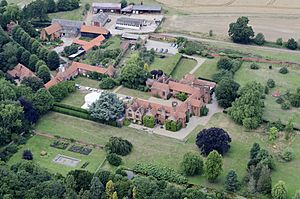John Petre, 1st Baron Petre facts for kids
Quick facts for kids John Petre, 1st Baron Petre |
|
|---|---|
| The tomb of Lord Petre and Mary, Ingatestone Parish Church | |
| Spouse(s) | Mary Waldegrave |
| Issue | |
| William Petre, 2nd Baron Petre | |
| Noble family | Baron Petre |
| Father | William Petre |
| Mother | Anne Browne |
| Born | 20 December 1549 |
| Died | 11 October 1613 (aged 63) |
| Burial | St Edmund and St Mary's Church, Ingatestone |
John Petre, 1st Baron Petre (born December 20, 1549 – died October 11, 1613) was an important English nobleman. He lived during the time of the Tudor and early Stuart kings and queens.
His family were known as recusants. This meant they continued to follow the Roman Catholic faith. This was even after the English Reformation changed England's main religion. Despite this, Lord Petre held many official jobs in the county of Essex.
Contents
John Petre's Early Life and Family
John Petre was the only son of Sir William Petre, a well-known statesman. His mother was Anne Browne. She was the daughter of Sir William Browne, who was once the Lord Mayor of London.
John grew up at Ingatestone Hall in Essex. This grand house was the family's main home for many years.
A Love for Music
John Petre was a very talented musician. He owned a full set of musical instruments. These included a lute, five viols, virginals, and an organ.
He also supported the famous composer William Byrd. Byrd was also a Roman Catholic and lived nearby. Sometimes, Byrd would bring musicians to Ingatestone Hall. They would play music for Christmas celebrations. Byrd even dedicated some of his music to Lord Petre.
Marriage and New Homes
In 1570, John married Mary Waldegrave. Mary was the oldest daughter of Sir Edward Waldegrave. She was not wealthy when they married, but John's parents were very happy with his choice.
John and Mary had four sons. Their oldest son, William, later became the 2nd Lord Petre.
When John's father, Sir William, passed away in 1572, his mother continued to live at Ingatestone Hall. So, John and Mary, who lived at Writtle Park, looked for a new home. In 1574, John bought West Thorndon Hall and a lot more land. This new estate became the family's main residence.
Public Service and Nobility
After his father's death, Queen Elizabeth I made John a knight in 1576. Even though he was Catholic, he held many important jobs in Essex.
He was a Justice of the Peace (JP), which meant he helped keep law and order. He was also the sheriff of Essex from 1575 to 1576. From 1590 to 1598, he was a deputy lieutenant. He also served as a Member of Parliament (MP) for Essex in 1584-85 and 1586-87.
Becoming a Baron
In 1603, John Petre was given a special title by King James I. He became Baron Petre, of Writtle in the County of Essex. This meant he was now a peer, a member of the nobility.
After this, he openly said he was a Roman Catholic. His family continued to be Catholic for many generations.
Serving the Crown
John Petre was a loyal servant to the Crown. In 1589, Lord Burghley, a friend of John's father, appointed him to lead 600 foot soldiers.
By 1590, these soldiers were trained and ready. This was a time when England feared invasion, especially after the Spanish Armada. John Petre also helped investigate complaints from sailors and fishermen. They were upset about being forced to join the Navy.
In 1600, Sir John let his newly married son live at Ingatestone Hall. This was so his son could learn how to manage a large household.
King James I often needed money. He started selling titles like peerages to raise funds. However, John Petre's title was likely given for his loyal service. He was a Justice of the Peace, High Sheriff, Deputy Lieutenant, and a commander in the militia.
Later Life and Legacy
John Petre passed away at West Horndon, Essex, on October 11, 1613. He was buried at St Edmund and St Mary's Church, Ingatestone. He left behind three sons and one daughter.
He also gave more money to Exeter College at Oxford University, just like his father had. He also contributed a large sum of money to the Virginia Company, which helped set up colonies in America. His son, William, took over his title as the 2nd Baron Petre.
Memorials
There are two paintings from 1590 that were once thought to be of John and Mary Petre. They are part of a collection called the Petre Pictures. These paintings were restored after a fire in 1876.
An art historian named Roy Strong believes these paintings are actually of John's son, William Petre, and his wife, Katherine. The portraits show the fashionable clothes of the time. Lord Petre wears a white ruff and an embroidered jacket. His wife wears a large skirt and a beautiful pearl necklace.
John and Mary Petre also have a stone tomb in the Ingatestone Church.
| Peerage of England | ||
|---|---|---|
| New title | Baron Petre 1603–1613 |
Succeeded by William Petre |



